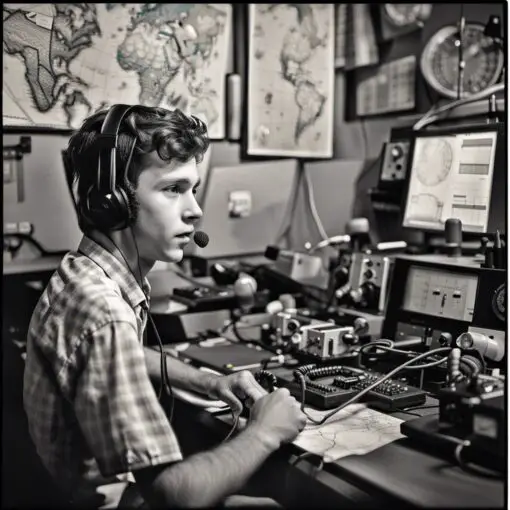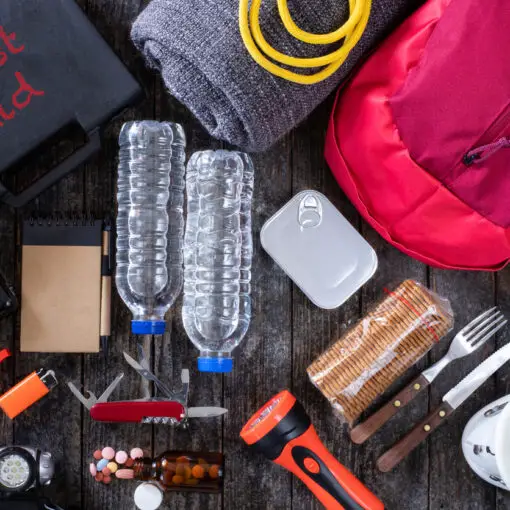You’re completely off the grid, perhaps a hundred miles from the nearest convenience store or any kind of civilization for that matter. Do you want your smartphone with you or do you want something that has the potential to give you thousands of miles of coverage, regardless of where the nearest cell tower is?
For anyone that enjoys overlanding and taking themselves well off the beaten path will want something to be able to communicate with, just in case something goes wrong. In fact, it’s one of the most important tools in your kit.
Ham radios are one of the best tools you can carry along with you, especially if you are licensed as an Amateur Radio operator because you will be able to take advantage of all of the frequencies and distances applicable to amateur radio.
Ham radio is such an essential part of overlanding and taking a break by going off the grid, however, not all Ham radios are created equally, so we’ve compiled a list of not only essential Ham radios for such a trip but also the best of the bunch.
How Ham Radios Work
If you’re new to amateur radio, you may have visualized a Ham radio as something along the lines of a gigantic box that sits on the desk, complete with archaic knobs, false wood aesthetics, red needle gauges, large cords, and an old school mic.
Fortunately, Ham radio has come a long way and now you probably couldn’t tell much of a difference between a Ham radio and a standard, run-of-the-mill walkie-talkie. That is until you snatched a closer look.
The FCC (Federal Communications Commission) makes a number of frequencies—above the AM band—available to those who have the appropriate license. Ham radio operators are allowed to use those frequencies above the AM band up to microwave bands.
Ham radio users can also take advantage of Morse code, especially when voice transmission or reception is all but impossible. You don’t need a cell phone and you don’t need access to the internet.
You Can’t Legally Use Ham Radio Without a License
Technically, you can get away with it in an emergency situation after all of your other options are exhausted, but for regular use of a Ham radio, you will need a license. There are three types that you can get, depending on how far you want to go and what level of freedom you want to obtain.
Technician
Technician class is the first license and this is where beginners get started. Once obtained, you will have access to all bands above 50MHz along with a few additional privileges with other bands.
General
The mid-tier license is the General Class and it gives you access to almost everything that you get with the Amateur license, with a few exceptions. There’s a lot more information to be had as a General Class as well.
Amateur
Your Amateur license is the highest achievable license that you can get as a Ham radio operator/user. It allows you to access by receiving or transmitting on all of the bands made available by the FCC.
Having a license to operate a Ham radio is a necessity, most notably because you’re looking for a Ham radio to use off the grid.
Features to Look for in a Ham Radio for Overlanding
If you’re just dipping your toes into the world of Ham radio and have your shiny new license, you may have a little trepidation when it comes to finding the best Ham radio for overlanding and spending extended periods of time off the grid.
- Vehicle-mounted or handheld
- Power
- Range
- Anti-interference
- Accessibility and ease of use
Unless your overlanding plans don’t involve a vehicle at all, you’ll want to decide on whether you want to go with a handheld or a vehicle-mounted Ham radio. There are advantages and disadvantages to both.
The handheld gives you plenty of portability since you can take it anywhere you’re going, in or out of your vehicle. Unfortunately, they’re generally limited power-wise, with most handhelds operating at 5W while vehicle-mounted Hams are 10x that amount.
Power itself is an issue as well, unless you’re toting some solar equipment, you’ll be dependent on the longevity of a handheld battery, while a vehicle-mounted Ham radio draws power off of your car battery.
You should always look for anti-interference tech as well. Although it probably won’t be a problem, you never know what might affect your ability to communicate. It’s not as if you can see the wireless signals that potentially cause interference and can swipe them away with your hand.
Accessibility and ease of use are pluses as well, Ham radios can get quite complicated at times, and when you’re on your 5th day, out in the middle of nowhere, it’s nice to be able to depend on your ability to do exactly what you need to do, without having to figure it out first.
On that last note, it’s important to figure out every aspect of your Ham radio before you embark. It’s never good enough to assume that you know, even if you have some knowledge and experience with other, similar Ham Radios. An emergency is not the time to be scratching your head over your radio.
5 Best Ham Radios for Overlanding
Now that we’re all on the same page and you know what you’re going to need, we can focus on the best Ham radios on the market today that are perfect for overlanding. We’ll focus on both handhelds and vehicle-mounted Ham radios so all of the bases are covered.
1. TYT TH-9800 Quad-Band
The TYT is a vehicle-mount, quad-band, Ham radio that’s loaded to the brim with features and settings. Enough to make any Ham radio enthusiast proud. It may be a little much for the newbie crowd, so spend a little time with it pre-trip and learn all of the ins and outs.
The TYT transmits in 10M, 6M, 2M, and 70CM bands and can also switch over to the good old AM band if you feel like catching some talk radio on the ride out. It’s loaded with over 800 channels and comes with a full dial pad on the mic for a bit of convenience.
The Alphanumeric memory channels are great for when you need to keep everything organized and transmitting where you want is right there, at the touch of a button. At 50W, you’ll have the power and the distance and since it is vehicle-mounted, it’s practically a part of your factory radio.
It comes with everything that you need to easily set it up and mount it inside your vehicle, with an included mic hanger because these things are pretty standard by now, and lacking something like that is a deal killer.
What is truly remarkable is that it comes with an outstanding quad-band performance at a budget price, which includes balanced power settings, 800MHz scanning functions, 5W at its lowest, 65W on VHF, and 45W at UHF. All in all, not bad for just a shade over $200.
Most customer reviews label the audio at moderate to high quality, with the most commonly reported problem indicating that there is a slight bit of distortion when holding the mic too close to your face.
At its highest power settings, you would need an additional power adapter, but unless you really need to max this thing out, that should never be a problem.
The TYT offers 256 memorizations along with a robust set of functions that deserve some time to gather them all in. It includes a DTMF mic and—in addition to the AM setting—has a digital FM band available as well.
Last but not least, the TYT also comes with tone search scan, programmable memory scan, DTMF signaling, and Automatic Repeater Shift (ARS).
| Pros | Cons |
| Quad-Band at a budget price Multiple power settings Excellent range Large LCD Display 800 memory channels 8 group voice scrambler | Possible distortion issues with the mic Cross-band repeater mode is sometimes glitchy |
2. Kenwood Original TM-V71A
The Kenwood TM-V71A isn’t going to blow you away in the looks department—it’s a pretty standard-looking, vehicle-mounted Ham radio—but it is one of the best, dual-band Ham radios on the market and you will quickly forget about the mundanity of its aesthetic appeal.
It manages to do a lot with dual-band because you monitor two frequencies simultaneously for true, dual-band operation. The TM offers 1,000 memory channels and you can identify each one with 8 keys.
As with most vehicle-mounted Ham radios, the power output is 50W with the ability to adjust it down to 10W or 5W. Unfortunately, there’s no happy medium here, so you’re essentially stuck with either high or low power options.
If you happen to be in an area with the internet, this Kenwood supports EchoLink, which is a connection feature that you can build an online community around by connecting with other members. Since this is primarily for overlanding, however, that’s not likely to be an option.
The detachable control head allows for easily transitioning from a permanent setup at the house to inside your vehicle and on the go. The front of the Kenwood features a standard LCD panel with the option to switch between red and amber backlighting.
Although this radio isn’t quad-band, you are getting a true dual-band experience at a pretty good value, as this is certainly not on an upper-tier price range.
The 104-code digital squelch effectively keeps the background noise down and the audio is excellent in terms of quality. It’s great to have a Ham radio that offers an easy user experience. Kenwood seems to understand that not everyone that picks one of these up is an expert.
So the ease of use is a welcome addition, on top of all of the advanced features. However, if you want to make the programming options even easier, you’ll have to purchase both the software and cables separately.
| Pros | Cons |
| Ease of use True, dual-band 1,000 memory channels Adjustable from high to low power Simple interface 104-code digital squelch | No mid-power option Some ease of use features are sold separately |
3. Xiegu G90 HF Radio
The Xiegu G90 is definitely a high-performance device and the price tag is a reflection of that. It is one of the more expensive options on our list. Right off the bat, you have a degree of portability with the detachable head with a bright, and clear LCD that’s hands and feet above most in its class.
It comes with a mediumwave that’s built-in for AM broadcast under a high-pass filter. The Xiego has a built-in automatic antenna tuner so you don’t have to “purchase one separately,” a phrase that is incredibly annoying to anyone spending the kind of money to bring one of these home.
Thanks to their innovative, multi-functional, digital microphone, you can operate the transceiver completely hands-free. The buttons on the mic are programmable as well, so the need to put your hand on the transceiver is unnecessary unless you just prefer to do it that way.
The display is crystal clear and you will always have a solid understanding of your current signal conditions thanks to the 48KHz wide spectrum display.
The screen is absolutely packed with all of the information you need to know, however, despite the clarity, the screen is small enough that it has a cluttered look and feel to it.
When you open the box for the first time, you’ll be surprised at all of the items Xiegu packs in there.
You get everything that you need to install the radio anywhere you need, whether that’s a permanent setup or completely mobile. You also get a DB-9 Remote head cable, something that manufacturers often make you pay for separately.
Of course, you get the transceiver and mic in addition to a firmware and power cable. Considering what typically comes out of the box, you get quite a bit of hardware and an additional cable with your purchase.
Despite all of the information packed into the display screen, along with the features that the Xiegu has to offer, this radio is still designed with a streamlined, easy-to-use interface. This includes a quick menu, so everything that you need is in front of you and the press of a button away.
The Xiegu also has outstanding audio, with its built-in anti-interference software working overtime to give you nothing but crisp, clean audio.
| Pros | Cons |
| Built-in Automatic Antenna Tuner Bright, info-rich LCD One-hand operation Streamlined and easy to use Outstanding audio Arrives with the DB-9 remote head cable | Screen is often cluttered with too much information Pricey |
4. BAOFENG BF-F8HP (UV-5R 3rd Gen)
The Baofeng is the first portable—as in, hand-held—on our list, and it’s definitely a good one. Unlink most handhelds that come with about 5W of power, the BF-F8HP 3rd Gen comes with 8W.
If 8W is too much for you, it can also be adjusted to 4W or 1W. The battery is a 30% increase in size over the second generation Baofeng and it comes with a V-85 High Gain Antenna to take full advantage of the extra battery power and wattage.
The new, 2000mAh battery will provide you with 20-hours of juice at full power, assuming that you are using it quite a bit throughout that time frame.
It has a broad and narrow band selection along with remaining fully backward compatible with previous iterations. Also, the kit that comes with it is enough for you to strap up and head out. You get a belts clip, hand strap, power adapter, and earpiece straight out of the box.
It is a dual-band radio but it runs on a more advanced chipset, however, on the release date, the Baufeng had horrible intermod issues, to the point where it was definitely a deal-breaker.
Fortunately, several firmware updates have been released since, with better squelch adjustments that have eliminated the problem. The Baufeng was already a high-performance radio, even under stressful conditions and succeeding updates have only improved on that.
In terms of clarity with the audio, regardless of location, it’s never bad but never transcends the level of what you would consider decent. If you’re looking for high-quality sound and clarity, you’re not going to get that here.
What you’re getting with this 3rd generation Baofeng is a radio device that is like the Energizer bunny. It just won’t give up, no matter what you throw at it. However, you’re not going to get incredible levels of clarity.
| Pros | Cons |
| Workhorse Ready to go out of the box Great battery life Three power settings Advanced chipset improved over time Very budget-friendly | Gets warm under heavy use Not the greatest audio quality |
5. Radioddity GD-77 DMR
This is more like the walkie-talkies of every middle-aged human being’s childhood. Of course, it’s more than just a walkie-talkie, though the look and feel could easily make you feel otherwise. The looks shouldn’t fool you, however, because this is an excellent little Ham radio.
As portables usually go, the Radioddity is a 5W, dual-band radio (UHF/VHF), with a dual-screen LCD that shows analog and digital signals. It is adjustable down to 1W, which is especially useful when the battery is getting low and you don’t have to reach out too far.
The VHF range for the Radioddity is 136-174MHz and 400-470MHz with the UHF. It’s a solid walkie-talkie that is built to withstand drops and the everyday abuse from spending a lot of time outdoors and on the trails.
The LCD is like an old-school digital watch, which is difficult to read in bright light and complete darkness unless you turn on the backlight.
Regardless of whether it’s digital or analog, the receiver sensitivity is outstanding with the bright, loud, clear sound emitted from a 1W amp. There are no customer complaints concerning clarity, however, some complain that it’s a bit high-pitched at times.
The battery is a 2200mAh lithium-ion battery and you can typically get a full day and a half out of it before it needs to be recharged.
The Radioddity comes with something called “promiscuous mode,” to go along with the standard Digital/analog mode. In promiscuous mode, you can listen to all talk groups at the same time, and it’s also compatible with hotspots, repeaters, and radio to radio.
In terms of sound quality, the Radioddity has some of the best audio clarity in its class.
It comes with everything that you can expect for a 5W DMR, including a belt clip, long and short high gain antennas, charger, battery, and programming cable. The programming cable plugs into the USB port on your computer and allows you to program certain features on the device.
| Pros | Cons |
| Very durable Powerful, long-lasting battery Dual-screen LCD Excellent receiver sensitivity 1,024 channel Promiscuous mode | LCD is tiny |
One thing that is definitely worth considering, is solar power. Whether you are into green energy or not, it’s inarguable that solar energy can be an invaluable tool that keeps you going when you’re long off the grid and need juice for your Ham.
Solar panels are portable and easy to set up and are the perfect answer for keeping your portable Ham radios up and running for the long term, especially if you have an additional replacement and/or rechargeable batteries.
If you’re going off the grid or overlanding, even if it’s just for a short period of time, the ability to maintain communications with the outside world is a critical part of your preparation. Bringing along a solar panel to keep your batteries topped off is always a good idea.
All Things Considered
Ham radios have gone well beyond the old, boxy sets that you could set on a desk with a forklift. They’re portable and so long as you have the appropriate license, an invaluable tool when you’re overlanding and spending some time off the grid.
The five Ham radios on this list are some of the best portable options out there, even if some of them are vehicle-mounted. No matter how far you want to explore, always keep at least one line home, because your safety is important.










